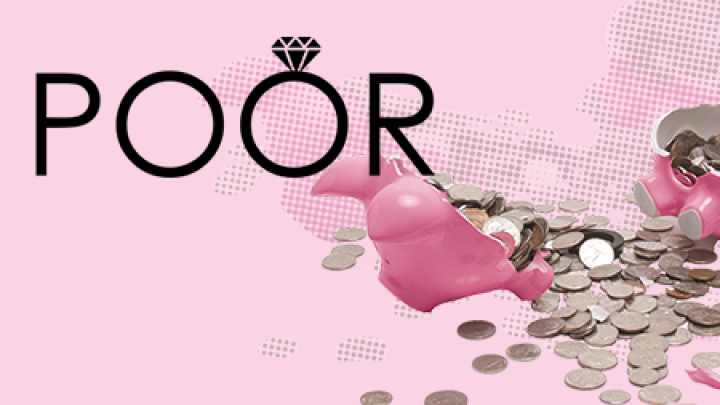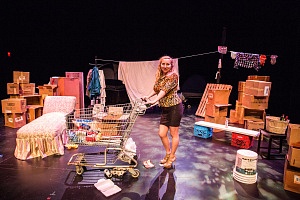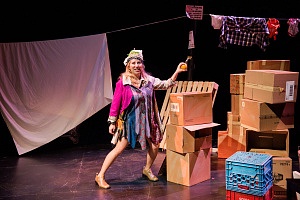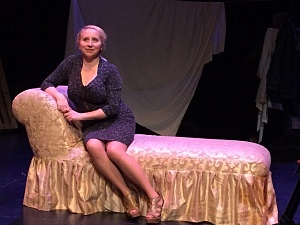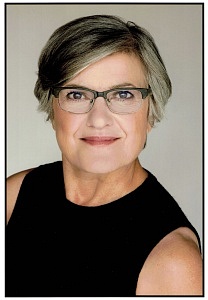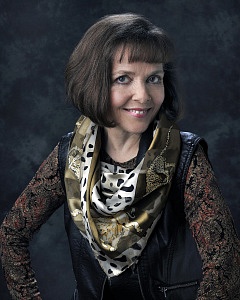It’s been a few weeks since the final performance of Brock University Department of Dramatic Arts’ Fall Mainstage, Scenes from an Execution. Closing off their...
By DART Critics
February 25, 2016
Caroline Coon, Sarah Bradford, Johnathan Clancy, and Daryl Hunter write:
February 16: We entered Robertson Hall in the First Ontario Performing Arts Centre at 7:20pm with excited anticipation. The cue to cue was well underway so we made sure to enter as quietly as possible. This was our first time witnessing Poor’s set to its full extent with lighting, sound, and video operation. Observing this transition was breathtaking: the set came to life right before our eyes.
Considering Beatrice (stage manager), Karen (director), Genevieve (assistant stage manager), Monica, and the production crew had been at the theatre since 8:00am, everybody seemed to be in high spirits. We briefly got acquainted with the designers and technicians that are bringing Karen and Monica’s vision of Poor to life: Jacqueline Costa, lighting designer; Ethan Rising, sound and video designer; and Brent Tomlinson, the house technician and lighting operator. With these designers/artists present and in action we got to witness many of the effects we talked about in our previous posts about rehearsals in the Flex Space — it was refreshing to watch our impressions of the script become a reality onstage.
From our experience as theatre students we can sympathize with how rigorous and lengthy a day like a cue to cue can be. Monica and Beatrice kept the tone light hearted and fun for everyone —Beatrice made hilarious comments such as “It’s cruel to put a big orgasm in the middle of a play then make her act for 20 more pages!”, and Monica produced zesty one liners during the sexual encounter scene with Joe such as “Sorry I came too early!” when she said a line before her cue. We agreed that this particular scene was our new favourite: the seductive music and Monica’s comical reactions make for an unforgettable moment.
Since Monica had much more space to work with in Robertson Hall than in the Flex Space, we wondered how her movements and scene transitions would translate. She has to cover a much wider space which can be fatiguing for an actor — a water bottle was placed in one of the boxes upstage where Monica goes during scene transitions. Beatrice and Genevieve cleverly filled any alcohol glass or bottle that Monica’s character Shelly has to drink from with water and food colouring: yet another display of quick thinking to accommodate to Monica in any way possible. At one moment Monica has to clean up the trash onstage during a transition: there was a significant amount that needed to be collected, but Beatrice and Karen maintained that not all of it needed to be cleaned up if Monica felt that she couldn’t get to it all.
Something we learned from this final visit as embedders for ECT’s production of Poor is that theatre processes can be unpredictable. According to Beatrice, the original plan for the day had been a full tech dress rehearsal, but due to inclement weather the day prior we ended up viewing a continuation of the cue to cue. Despite the minor setback Karen, Beatrice, Monica and the rest of the crew used their time efficiently and by the end of the night all sound/audio/visual components were finalized, any uncertainties that Monica had with sound/lighting cues were solved, all scene transitions were worked out, and everyone left with a great sense of accomplishment. Due to all this hard work and preparation the group was ready bright and early the next day to do a full run through.
February 17: When the day finally came for the tech dress rehearsal, the team was as ready as ever. Each designer/technician was in their place and doing their presets, Genevieve was helping Monica get ready backstage and Karen had her director’s notebook at the ready. Beatrice called “Places everyone. Cell phones off” and from there what unfolded before our eyes was a fantastic compilation of all the hard work we had witnessed prior to this come together. From the opening chant of “We are the 99 percent” to Monica’s final chilling yet informative monologue, we were awestruck. We left the theatre a little reluctantly; the realization that our time as embedders for Poor was over left us feeling somewhat disheartened, but at the same time just as excited as we were the moment we attended our first rehearsal. With its opening night on February 18th and its final curtain on the 28th, Essential Collective Theatre’s production of Poor promises audiences an unforgettable theatre experience — much like ours in witnessing the creation of this show.
February 20, 2016
Caroline Coon, Sarah Bradford, Johnathan Clancy, and Daryl Hunter write:
February 10th: “Welcome to the coziest rehearsal hall ever” says Monica as we get ourselves situated. Today there are even more boxes, a metal trash can, and bits of garbage all over the place. The set has developed and expanded since last we observed a rehearsal. It will be interesting to see what has changed since the stumble-through on our last visit.
Coming directly out of a production meeting, everyone is excited to get back into the rehearsal. Karen examines her script as Bea, the stage manager, prepares the scene with Monica. We’re beginning at a scene where Shelly is in a clinic during one of her escapades as “one of the Poor.” Here Shelly attempts to convince the doctor that she has Tourette’s Syndrome.
Monica is now off-book, with Bea giving her prompts occasionally — an impressive feat considering the amount of dialogue that Monica deals with in this show. Without her script, Monica is able to delve deeper into the character of Shelly and bring out even more of the humour in the play.
Using various expressions, tones, and gestures Monica channels her inner rock star, flirts with a homeless man, moves between a host of different characters, and makes love to a fistful of bacon. Monica’s antics had us laughing out loud throughout the run. It seems the production is in that wonderful in-between stage: There is a structure of blocking in place that can now be experimented upon and adjusted through rehearsal, making the experience like play.
Transitions (which are a crucial part of this show, and have been a focus of our embedding) are at the centre of this rehearsal’s experimentation. Monica went through costume and set changes — sometimes at the same time — as Bea played the music for each major change. Monica, Karen, and Bea discussed these changes frequently as they tried to narrow down how Monica could best move from one place to another, where props would go after a scene, and what changes in costume Monica will need to make. Sometimes the issue is more about the spacing of objects, a complex question at this point because, as Bea explains, “the actual space will be larger.”
Another frequent topic of discussion is props. As more objects are brought into rehearsal and Monica attempts to work in the space, this raises the question: where in this sea of boxes will every piece go? Many of them end up in the boxes themselves, with Bea and Genevieve, the assistant stage manager, keeping track of which nearly identical cardboard box will contain which props at different times.
After the discussions Bea and Genevieve take down notes of any changes and Karen often uses this moment to give Monica notes or to discuss a part of the scene that passed. It’s impressive to see how invested all parties in the production are in the show, down to the most minute details. With only Monica acting onstage and with so many props tucked away, this attention to detail is certainly necessary to keep the show moving.
For example, shortly after the clinic scene Shelly returns home to her son Spencer. Using a video game console she picks up in the transition, Monica embodies the young boy in her facial expression and physicality. The controller helps to communicate the divide between mother and son, so it’s vital to the scene that it be placed within reach of Monica so that she can use it to maximum effect.
In another scene Monica falls off a chaise after having a moment of extreme passion with some bacon that reminds her of the man she had sex with during one of her journeys pretending to be poor — a great scene. Unfortunately, in this rehearsal, she lands on a pair of shoes that were taken off in a previous scene. She takes the hit with good humour and a quick conversation follows about how to deal with the shoes. In no time the group moves on. The spirit of collaboration, of trial and error, in this production is amazing as the team works together efficiently and professionally while having fun as well.
With all these transitions and changes over the duration of the play it is understandably taxing for Monica. Karen suggests during a scene where Shelly is taking a drink from a scotch bottle that Monica may need opportunities to take a drink of water during the play as it looks like there will not be an intermission. Monica’s character does drink frequently — Shelly even states near the beginning that calling her an alcoholic isn’t far from the truth — so this may be a golden opportunity to give Monica a respite once the show goes on.
Soon it’s time for us to leave, but the rehearsal goes on and it won’t be long before we see them again.
February 13th: We return to the Poor rehearsal room and get an opportunity to see what new developments ETC has in store for us. The rehearsal begins with a fight call: During a trip to the downtown East Side, Shelly gets into a fight with a woman over an orange. As this is a one-person show this means that Monica is fighting air. Her reactions to the invisible person, however, make it easy for the audience to visualize her assailant. Karen and Bea work to make changes that heighten the presence of the invisible attacker — such as making eye-contact — and which will move the scene into the one following it seamlessly.
Monica then works with Genevieve over the lines for scenes that have had cuts since our last visit. Karen and Bea explain that certain areas of the show were dragging during the stumble-through, so they trimmed down the script in certain points to make it flow better for them. Once Monica feels comfortable with the changes she prepares for the top of the show — today we get to see a full run-through! Bea and Genevieve take notes and read stage directions for Monica while Karen remains focused upon the action onstage. The intensity in the room is palpable as the run begins.
Adding to our excitement, we have a chance to see what Monica will be wearing in the first scene. Walking onstage wearing a glittering gown and carrying a champagne glass we see Monica as the 1% — as Shelly Cormorant in all her finery. This scene is where Shelly is at her most naive and ignorant, which is disturbing to see coming from our pleasant Dramatic Arts professor. Out of this ignorance Shelly builds an idealization of poverty. Shedding her richness proves difficult, however, as Monica struggles initially through the transition from wearing her gown to her poor attire.
We do get a laugh once Shelly transforms and shows off her new poor disguise (as designed by Roberta Doylend) — a jacket of mismatched fabrics and a bizarre little hat pieces dangling off it. Shelly then visits the downtown East Side and we get to see Monica play between the imaginary world of the script and the audience. She makes amazing use of dramatic asides — the juxtaposition of her character’s ignorance, her brilliant timing, and the script’s biting humour is a winning mix. It is a fine line that the character and actor walks between comedy and insensitivity — something that Monica and Karen well understand.
There is a lot of improbable, edgy fun happening in these first few scenes: Shelly gets beaten up over an orange and has sex in an alleyway, attributes ailments to herself in a clinic as if she were ordering from a menu to create her impoverished persona “Patty Pickle”, and then pretends to be a prostitute as she hails her chauffeur. The goal is for the audience to laugh a lot through the first half. It makes the play even more rewarding as Shelly’s experiences begin to change her.
Watching the play we see a slow transition in Shelly as she begins to understand the realities of poverty. This change became apparent during what begins as an amusing puppet theatre dinner party using utensils as people. Shelly protests the excesses of the rich and begins to sing the anthem of Occupy — a moment that had us in chills with its haunting melody. While the story kept us laughing to the end, it is bittersweet in the face of what the play reveals about the state of the world.
After the run ended Monica got a moment to take a break. In Karen’s words: “bravo, that was a workout and a half!” We couldn’t help but agree. We then observed a notes session and saw how Karen’s notes have changed from previous visits. Before, she would give notes on the production moment by moment but now she has added points that comment on the play in its entirety — an intriguing adjustment as the production prepares to move into the First Ontario Performing Arts Centre (FOPAC). As we have witnessed in previous visits, Monica and Bea get opportunities to discuss notes and work out solutions.
The next time we visit it will be in the FOPAC—a dramatic change from “the coziest rehearsal hall ever.” Watch this space!
February 17, 2016
 Caroline Coon, Sarah Bradford, Johnathan Clancy, and Daryl Hunter write: As we arrived at the Flex Space in the old Courthouse building we were all excited to see what new developments would come from rehearsal. This is only the second rehearsal we’ve attended and already the pieces of Poor and the world of Shelly Cormorant have begun to come together. Some new additions have been made to the set since our last visit, and Karen and Monica have finalized the blocking. Today was all about running through the show and stopping to make revisions wherever Monica and Karen saw fit. All eyes were on Monica with a script in her hand: we were on the edge of our seats waiting to see her in action.
Caroline Coon, Sarah Bradford, Johnathan Clancy, and Daryl Hunter write: As we arrived at the Flex Space in the old Courthouse building we were all excited to see what new developments would come from rehearsal. This is only the second rehearsal we’ve attended and already the pieces of Poor and the world of Shelly Cormorant have begun to come together. Some new additions have been made to the set since our last visit, and Karen and Monica have finalized the blocking. Today was all about running through the show and stopping to make revisions wherever Monica and Karen saw fit. All eyes were on Monica with a script in her hand: we were on the edge of our seats waiting to see her in action.
Though Monica told us that she was feeling a tad low in energy, this didn’t come across at all. As soon as she stepped out onto the makeshift stage as Shelly it was as if a switch had turned, and now we were looking at a character wrapped up in her rich privilege and itching to “experience poor.” Though Monica proves in rehearsal her exceptional ability to transition from character to character by transforming her voice and physicality, a recurring challenge presents itself in the multiple costume changes the show requires.
From her opening monologue, to her first appearance as Patricia Pickle (her poor alter ego), to her lusty rendezvous with Joe (a man she meets on the streets), to being back at her lavish home, Monica must execute a multitude of costume switches on top of transforming the set from place to place and remaining grounded in the performance. An example we observed is after one of her scandalous meetings with Joe, Shelly has a scene with her son Spencer to whom she explains some of her “poor” adventures while leaving the poor behind and changing into a lavish silk bathrobe. The change is quick, subtle, and represents Shelly’s ability to easily separate herself from her poor life. Karen worked well to assist Monica at times where the blocking of a costume transition gets fuzzy, often physically entering the playing space and walking Monica through it step by step.
This rehearsal was a great opportunity for us to have a first glance at Karen’s directing style. We noticed her openness and collaborative ability whenever Beatrice (stage manager) had suggestions about blocking, scene transitions, or line delivery; the three worked well together whenever a problem surfaced that would halt Monica’s performance. We had a few chuckles as Karen imitated music transitions and sound effects, seeing as how there was limited room for tech equipment in the space. All in all it was endearing to witness a director such as Karen who is dedicated to her actor make sure that she is comfortable from scene to scene and at the same time receive and utilize feedback and ideas from her stage manager.
As the rehearsal came to a close Monica, Karen, Beatrice and Genevieve (assistant stage manager) sat around the table and discussed notes. Monica intently listened to Karen as she fed back what she’d observed in this session. The consensus was that elements such as tone, gesture, physicality, and responses are key to the effectiveness of Monica’s transitions from character to character and to the buildup to the play’s climax, which Monica explained she was struggling with. Karen and Bea were reassuring and let Monica know that she has lots of time to work up to the intensity of that scene. Karen didn’t think they’d get through a full run through because of all the fine details that needed to be worked out that day but the hard work of this team paid off, leaving us embedders gleefully anticipating our future visits and wondering what new discoveries and advancements will be made in the next rehearsal.
February 12, 2016
Caroline Coon, Sarah Bradford, Johnathan Clancy, and Daryl Hunter write: We arrived for our first rehearsal observation of Poor at the old Courthouse building (101 King Street) in Carousel Players’ Flexspace rehearsal room. Also present for this rehearsal were stage manager Beatrice Campbell and assistant stage manager Genevieve Bain. The brightly lit room was very small for 8 people to squeeze into, but the creative team made it work for their needs. Performer Monica Dufault was in the room adjacent warming up her voice, and Karen (the director), Beatrice, and Genevieve were setting up the rehearsal version of the scenery for the play. This was the group’s first time putting the stage together, so there was a tangible sense of anticipation and excitement. This took a lot of time, and right away technical decisions were being made about the setup of each quadrant of the stage. Upstage was mostly dominated by a large fabric sheet held up between the doorframe of the rehearsal hall and coat rack anchored by sandbags. This combined with stacks of cardboard boxes, a grocery cart filled with odds and ends, and an old baby stroller give the rehearsal space a distinctly humble feeling.
The bulk of the rehearsal consisted of Karen and Monica walking through the various transitions from the top of show. It’s clear that a conscious decision has been made to keep Monica on stage at all times. As such, many of the set transitions are cued by her walking around a corner, disappearing from one setting and re-appearing in a new space. These transitions were not enacted today, but we do know that Monica herself will make all the set changes, and at times has minor costume changes. We do not know what these changes will look like yet, and it is also unclear if there will be music or a lighting change during these quick transitions. The stacks of boxes will usually serve the purpose of blocking Monica from view, but for more complex costume changes it looks like she will move behind the upstage screen. Much of the set-up seems to be quite malleable and the scene can change simply by Monica’s character, Shelly, acknowledging where she is. The rehearsal area is roughly a third of the size of the final stage, so room to maneuver and set up a workable stage was difficult to find. Nevertheless, Karen is tenacious and dedicated. When she knows what she wants, she is determined to find a way to get it. The small space in no way deterred her. She can sometimes appear very intense, her eyes boring holes into whatever has her attention or scrutiny. This is always undercut by a humorous and creative energy. She is dedicated to her craft — end of story.
Perhaps the most intriguing part of this rehearsal was the use of props and set pieces. Each piece has a multitude of uses in the show and can change purposes from scene to scene. The aforementioned boxes, for example, begin as a way for Shelly to maneuver from one scene to another but also represent people in various scenes. The chaise, set downstage center, is perhaps the most creative piece as it constantly changes from upscale home furniture to a grubby discarded chair in a back alleyway. It’s amazing to see how conventional items with a base identity can be made to signify something else depending on Monica’s actions and speech when she enters the new setting. The stage is very much alive in this rehearsal; it almost feels like a ninth person in the room.
The stage is being set, but it’s still hard to get a feeling of where Karen and Monica want to take the play emotionally. Being part of the process this early brings to light just how important lighting and sound are to theatre’s affect. They set the mood and the emotional tone for the play. There were a multitude of instances where Karen would allude to a sound cue coming in here, or a projection happening now, or voice over, and all we could do was imagine it. It gave perspective on how challenging it can be sometimes to build a smaller show that does not have the resources to provide these technical elements early in the process.
Monica was very excited to be getting underway; that much was easy to see. As soon as she came into the room she walked right up to each of us and gave us promotional cards for the show with a big smile on her face. She is both actor and artistic director for ETC so one can only imagine the amount of effort and care that she is putting into this production. It’s tough to get under Monica’s skin. The painstaking process of building of the stage did nothing to deter her bright mood. She was always quick with a humorous jab and a flashy smile, something that we, the embedders have come to expect from working with her previously during our time at Brock University. She was in all blacks and ready to work.
Beatrice and Genevieve took note of everything that happened on stage and were consummate professionals. We all admire the level of intense listening it takes to be a stage manager. This particular show seems to present a daunting task when it comes to noting every use of each on-stage item. This team clearly works well with each other and is aware of the strengths of each person involved.
Of course no early rehearsal is perfect, and we still have many questions and queries moving forward. How much separation will there be between the worlds of rich and poor? The scene and costume changes happen by going around corners and disappearing for a moment, but how many times will Shelly be changing costumes? How do they plan to stage scenes like the dinner party in which Monica will be playing a multitude of characters at once? The excitement of not only discovering these answers, but being part of the discovery process is what being an embedder is all about, and we eagerly look forward to seeing it evolve in our next visit. After all, Karen said it herself: “I think that’s a very rough shape — it will probably all change.”
February 3, 2016
Caroline Coon, Sarah Bradford, Johnathan Clancy, and Daryl Hunter write: On Wednesday January 27th, the four of us sat in a classroom at the Marilyn I. Walker School of Fine and Performing Arts of Brock University, eagerly awaiting our meeting with Monica Dufault and Karen Wood – the two women in charge of bringing the play Poor to St. Catharines. Monica is the artistic director of the producing company, Essential Collective Theatre (ECT), and is performing in this one-woman show; Karen is the director. Any nerves we had were quickly put at ease, partly because many of us had been taught by Monica in our first year and also because they were both incredibly warm and open as we began our conversation. As embedded critics we are reporting on this creative process we are observing to you — the readers — so that you can follow the journey of this show with us from conception to performance.
Before the meeting we had read the script by Vancouver playwright Suzanne Ristic and were instantly captivated. Monica will be playing 23+ characters ranging from a rich, high-society woman, to a homeless man named Joe, to a French costume designer. The premise is that Shelly, a “Real Housewife of Vancouver” type, is unsatisfied and uncomfortable with her life, and creates an alter ego named Patricia Pickle so she can go out into the slums of the city and pretend to be homeless. Poor tackles a number of timely issues, particularly around poverty and the divide between the 99 and the 1 percent.
When we asked Monica and Karen why they selected the show, Monica explained that she had heard about it when it premiered at the Vancouver Fringe Festival in 2014, and contacted the playwright. Ristic was still altering the script at that point and sent Monica multiple drafts as the show developed. Monica was intrigued by the story and the challenge it presented an actor and decided that she wanted to perform in the show herself. Having directed a number of productions for ECT in recent years, it is quite the change for her to be performing in her own company’s work. Monica contacted Karen about directing; the two have known each other for years but never had the opportunity to work together. Karen told us that she is primarily an actor, but after having read and loved the script, she decided to put on her directing hat. She described the show as “topical” and “about everything going on in the world today.” Karen also mentioned how limited the opportunities to work in theatre in the Niagara region are, so a job close to home was an exciting prospect.
Although Poor is set in downtown Vancouver, with many references being made to this location in the script, Monica wants to change it into a universal story because poverty and homelessness exist in every city. She intends to use the piece as a means to open up a dialogue about poverty in the Niagara region, hinting to us that a symposium is in the works for late February.
We were all especially curious about how Monica and Karen plan to tackle a one-woman show with so many characters: how do they plan to make this work for the audience without causing confusion? Monica explained that throughout the whole play she is Shelly telling her story to the audience and when she switches characters she’s acting out Shelly’s impression of that person. Monica has experience working on her own onstage; in fact this is the third one-person show she’s done: “It frightens me that no one wants to play with me!”, she jokes. Karen added that in a workshop in December, they came up with a variety of different storytelling devices so as to not overwhelm Monica or the audience. For example, they plan to use tabletop puppetry for a dining room scene where there are supposed to be nine or more people in the room. We can’t wait to see how that turns out!
Part of Monica’s work as a performer will include executing costume and set changes while remaining onstage — a daunting task for a lone actor. Since Monica and Karen are hoping to tour the show later on, their goal is to make the set as efficient as possible, using boxes with props inside of them. The responsibility is Monica’s to transform the stage, Karen told us. When we probed a bit about those touring plans, they mentioned looking into festivals like Summerworks in Toronto and a one-person-show festival in Victoria, as well as looking at companies of a similar size to Essential Collective Theatre which might like to collaborate on a run of the production.
No matter where the show ends up playing, Monica and Karen are prepared for mixed feelings about its content. Poor includes many moments where Shelly and the characters she plays display blunt ignorance regarding homelessness and poverty; Monica, who feels sensitivity to these issues is very important, says she has to remind herself that she is playing an “ignorant, wealthy bitch.” Both she and Karen commented that they know the audience won’t like Shelly in the beginning, but they’re hopeful that sympathies will shift as the play goes on. Monica noted that Shelly’s ignorance is what informs her performance of the other characters, such as Rhonda, a lower-class black woman. As the play progresses, Shelly goes through a learning curve in terms of her personal values and her understanding of the world — though Monica notes that it’s up to the audience to decide whether that change is for the better or not.
How do they anticipate the audience is going to react? Karen says that many people assume that by putting something onstage, it’s being glorified, but that’s certainly not the intention with Poor. Poverty and mental ignorance – and ignorance about them – are “real, and … out in the world” and if art doesn’t address these subjects they’ll continue to be ignored. Both she and Monica agreed that people will probably be offended by Poor, but that is where a dialogue can begin. They both were drawn to the play because it is edgy and funny while treating material that some may find offensive (ECT is advertising the show as containing mature content and suggest a viewing age of 18) realistically. We loved how Karen put it when she said: “all we’re doing is producing something that exists in our society today. We don’t have to apologize for presenting it. If you can’t handle that, you probably shouldn’t go to theatre, ever… and if you don’t present this in its full form, you’re not being truthful to the piece.”
As our time with Monica and Karen drew to a close, we asked what they will want audiences to leave Poor thinking about. Their intent is not to preach, Karen was quick to explain; they don’t want anyone to leave the theatre feeling as though they had been lectured to. They want people to leave fascinated, and with an understanding of what put Shelly on the path she follows throughout the play. It’s important to them for audiences to sit with the knowledge that bad things can happen to anyone, even someone from extreme privilege. Poor will raise questions and point out problems, but they can’t tell people how to feel.
Overall, we felt that our meeting was successful and we are thrilled to be on board this project as embedded critics from the very beginning. After just a brief glance into the future of this show we are excited to see this process and witness the script bloom into a performance.
Related Posts
Here’s Holly Hebert’s final solo vlog from behind the scenes of the Fall 2020 DART Mainstage, Scenes from an Execution. She and Asenia will round off this...
Scenes from an Execution has opened, and even as someone working on it I was floored by how well the ambitious design turned out and how far the actors have...
Here’s Holly Hebert’s final solo vlog from behind the scenes of the Fall 2020 DART Mainstage, Scenes from an Execution. She and Asenia will round off this...
Scenes from an Execution has opened, and even as someone working on it I was floored by how well the ambitious design turned out and how far the actors have...
Leave a Reply (Cancel Reply)
Twitter Feed
Blogroll
DARTcritics.com is partially funded by the Marilyn I. Walker School of Fine and Performing Arts, in support of student learning; experiential education; student professionalization; public engagement with the teaching, learning and production activities of the Department of Dramatic Arts; new ways of thinking; and the nurturing of links with our communities.

